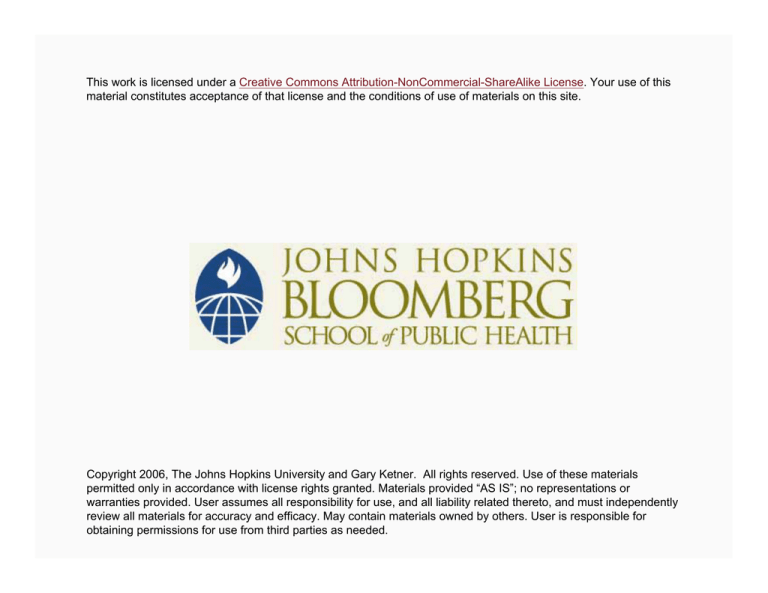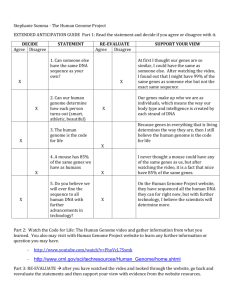
This work is licensed under a Creative Commons Attribution-NonCommercial-ShareAlike License. Your use of this
material constitutes acceptance of that license and the conditions of use of materials on this site.
Copyright 2006, The Johns Hopkins University and Gary Ketner. All rights reserved. Use of these materials
permitted only in accordance with license rights granted. Materials provided “AS IS”; no representations or
warranties provided. User assumes all responsibility for use, and all liability related thereto, and must independently
review all materials for accuracy and efficacy. May contain materials owned by others. User is responsible for
obtaining permissions for use from third parties as needed.
Genomics and Infectious Disease
Gary Ketner, PhD
Johns Hopkins University
Section A
Overview: Genomics, the Human Genome Project,
and Public Health
Genomics
Genome: an individual’s complement of genetic
information
− Frequently taken to mean the nucleotide
sequence of the genome
Genomics: the study of the genome (or of its
sequence)
Transcriptome: the mRNAs present in an individual,
organ, or cell
Proteome: the proteins present in an individual, organ,
or cell
4
Sequenced Genomes
Viruses (1,674 sequences as of 10/01/04)
− First sequenced genome: φX174 (1978) 5,386
nucleotides (0.005 Mb)
Archea (19)
− Thermoplasma volcanium (1.6 million bases; Mb)
Bacteria (173)
− First sequenced free-living organism: Haemophilus
influenzae (1995) 1.83 Mb
− Vibrio cholerae (2001) 2.96 Mb
− Mycobacterium tuberculosis (2001) 4.40 Mb
http://www.genomesonline.org/CompleteGenomesList.html
Continued
5
Sequenced Genomes
Eukaryotes (28)
− Plasmodium falciparum (2002) 22.9 Mb
− Anopheles gambiae (2003) 278 Mb
− Human (2001 [draft]; 2003 [ref.]) 2900 Mb (2.91
billion bp)
X Total file size, downloaded sequence: 841 Mb
http://www.genomesonline.org/CompleteGenomesList.html
6
Genomics and Public Health
Genomics is a tool of extraordinary power in the
investigation of biology
Because biology is central to most public health
problems, an understanding of biology is essential
Genomics is a potential contributor of immense value
to public health
7
Human Genome Project (HGP)—Circa 1991
Goal
− Complete DNA sequence of the human genome
Schedule
− 15 years
Cost
− A few billion dollars
8
HGP: What We Knew to Begin With
DNA is the genetic material
Information is encoded in DNA in the order along its
length of the bases A, T, G, and C
The human genome is big: >109 bp
From genetic and molecular studies (humans and
model organisms)
− A general outline of the organization of the
genome
− The nature of genes, regulatory elements, and
other components of the genome
9
HGP: What We Hoped to Find Out
The raw sequence
− A string of more than a billion As, Ts, Gs, and Cs
From this, we hoped to deduce:
− The DNA sequence of all of our genes
− The amino acid sequence of all of our proteins
X The functions of all of our proteins
− And a lot more
X Evolutionary relationships
X Regulatory mechanisms
X Bases of normal and abnormal development
X Determinants of genetic disease and disease
susceptibility
10
Section B
Sequencing and Finding Genes
The Approach: Shotgun Sequencing
Generate raw sequence data in vast quantities from
short, randomly produced pieces of human DNA—by
highly automated procedures
Assemble these sequences computationally to
generate a complete sequence
Annotate the sequence (identify genes, etc.), again by
computation
12
Shotgun Cloning
Isolate genomic DNA
Randomly fragment
(average sizes 2kb, 10kb,
50kb)
Continued
13
Shotgun Cloning
Use fragments to prepare
clones/clone libraries
− 2kb: 5,000,000
− 10kb: 2,500,000
− 50kb: 500,000
− 37x coverage
14
Shotgun Sequencing
Determine 500bp sequences from each end of each
clone
− 273 x 106 sequence reads
− 14.9 x 109 base pairs read
− 5x sequence coverage
Send the sequence file to the assembler
15
Assembly
Continued
16
Assembly
Continued
17
Assembly
18
The Reference Sequence of the Human Genome: Stats
The total sequence consists of 3.09 x 109 bp
− Haploid amount
− Includes both X and Y
There are 400 gaps in known places, containing 1% of
the DNA and relatively few genes
Accuracy: 99.99%
Cost: $2.7 x 109
Download it
− http://www.ncbi.nlm.nih.gov/genome/seq/
Continued
19
The Reference Sequence of the Human Genome: Stats
What is the reference sequence?
− The sequence of one human's genome?
− The “average” sequence of all human genomes?
− The “normal” sequence of the human genome?
− None of the above?
The reference sequence is a composite
− Assembled from good quality pieces of several
individuals’ sequences
− It is nobody’s genome, exactly
− Presumably, it would give rise to a fully functional
individual
Individual genomes can be efficiently described in
terms of differences from the reference sequence
20
Finding Genes
Proteins mediate most of the processes that occur in
living cells
− Proteins are responsible for normal and abnormal
metabolism, development, and disease
susceptibility
Genes encode proteins
Gene identification is a primary goal of the HGP
Continued
21
Finding Genes
Genes can be identified in the DNA sequence
computationally
− Genes contain open reading frames (ORFs)
X DNA sequences that can be used to predict
amino acid sequence by means of genetic
code
− Genes show characteristic usage of the genetic
code words for amino acids
− The coding sequences of a gene fall within length
limits
− Genes are flanked by punctuation for transcription
and translation
22
Gene Function
About 30,000 genes have been found in the human
genome
− Twice as many as in a fly
− Five times as many as in yeast
About half of the genes in the human genome are
identical or similar enough to genes of a known
function to confidently assign function
− More exciting, half are not
23
Fun Genome Facts
The total amount of DNA accounted for by genes is
about 1.5% of the total DNA in the genome
− Introns account for a substantial fraction of the rest
− About half of the human genome consists of
transposons (mobile genetic elements) with no
known function
Some of our genes entered our lineage from bacteria
relatively recently (600 mega years—after the
divergence of vertebrates and invertebrates)
− These genes largely encode enzymes that deal
with xenobiotic chemicals (monoamine oxidase)
24
Section C
The Plasmodium falciparum Genome
The Plasmodium falciparum Genome
Sequenced by a joint effort including publicly and
privately funded components
Completed in 2002
23 Mb
5,268 genes/proteins
− 40% related to genes in other organisms
− 60% unique
− The Plasmodium proteome is somewhat poor in
enzymes (parasitic lifestyle)
X But it is rich in genes involved in immune
evasion and cell adhesion
26
The Pf Genome and Vaccines
The P. falciparum proteome constitutes a complete list
of all of the Pf antigens that might induce protective
immunity
Potential targets that could be identified using
genome data:
− Merozoite surface or adhesion proteins
X Antibody neutralization of blood stage
parasites
− Proteins expressed specifically in liver cells
X CMI against infected hepatocytes
− Proteins expressed on gametocytes
X Transmission-blocking immunity
27
The Pf Genome and Drugs
Drugs must be specific
60% of the malaria genome is unique, and all of those
genes are potential drug targets once their function is
known
Several Pf enzyme systems have been identified from
genome data as similar to bacterial enzymes
− Most are associated with a specialized organelle
called the apicoplast, whose evolutionary origin is
bacterial
− Immediately exploitable targets for drugs
28
Isoprenoid Metabolism in Pf
Isoprenoids are a class of biochemicals with a wide
variety of functions in all living things:
− Cholesterol
− Sterol hormones
− Vitamin A
− Dolichol
Isoprenoid synthesis proceeds by successive additions
of isopentenyl diphosphate to a growing molecule
Continued
29
Isoprenoid Metabolism in Pf
Isopentenyl diphosphate is made in one of two ways
− In animals (including humans)
X Via mevalonic acid and the enzyme HMG CoA
reductase
Continued
30
Isoprenoid Metabolism in Pf
Isopentenyl diphosphate is made in one of two ways
− In plants and bacteria
X Via deoxyxylulose-5-diphosphate (DOXP) and
DOXP reductoisomerase
Continued
31
Isoprenoid Metabolism in Pf
P. falciparum has no HMG CoA reductase
However, the genome sequence revealed that it does
have the enzymes required by the bacterial pathway
(including DOXP reductoisomerase)
32
Isoprenoid Metabolism in Pf
Inhibitors of DOXP reductoisomerase exist
One of these, fosmidomycin, kills Pf in culture, and is
therapeutic in Plasmodium infection in mice and
humans
33
More Candidates
Aromatic amino acid synthesis via shikimate
Fatty acid synthesis by the type II pathway
Both present in Pf; absent in humans
The crystal structures of the type II enzymes are the
targets of a JHSPH study, with the goal of designing
inhibitors based on structural data
34
The Anopheles gambiae Genome
278 Mb
13,683 genes/proteins
− 1/2 shared with Drosophila
A. gambiae is the most important vector for malaria in
Africa
− Some strains of A. gambiae don’t transmit malaria
because they don’t support parasite development
− Genomic data is being used to identify the
Anopheles genes responsible for this strain
difference
35
Mosquito Engineering
The plan
− Identify a gene that will prevent malaria growth in
mosquitoes
− Genetically modify mosquitoes to carry that gene
on a transposon
− Introduce these mosquitoes into the wild, where
the transposon will propagate through the
population
Efficient propagation of transposons has happened in
nature in Drosophila populations over a few
generations
Continued
36
Mosquito Engineering
The issues
− What genes are
required?
− Population structure—
will spread occur?
− Will engineered
mosquitoes be fit?
− Can engineered
mosquitoes be released?
X Safety
X Politics
37
Light at the End of the Tunnel?
A. Crisanti, Imperial College, London
Mosquito larvae engineered to express foreign gene (green fluorescent protein).
38









